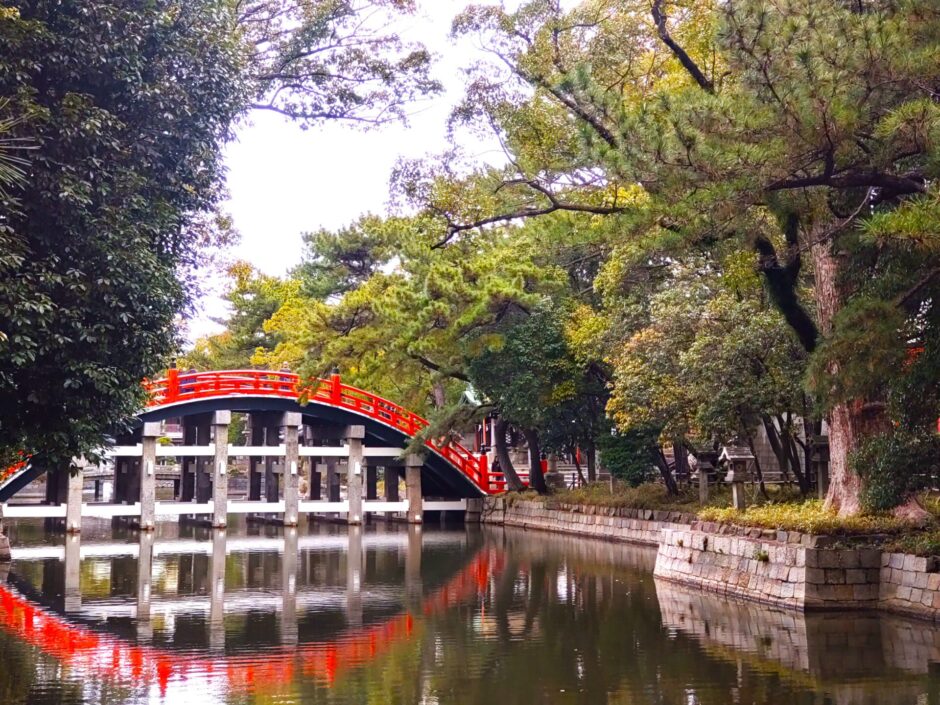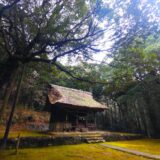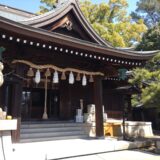目次
- 【Sumiyoshi-Taisya summary】
- 【Sumiyoshi-Taisya Anti-Bridge (Taiko Bridge)】
- 【Sumiyoshi-Taisya precincts】
- 【Sumiyoshi-Taisya first and principal shrine】
- 【Sumiyoshi-Taisya Nankunsha Shrine and a couple of camphor trees】
- 【Sumiyoshi-Taisya surroundings】
- 【Sumiyoshi-Taisya Access】
- Manager’s Comments
- Sumiyoshi-Taisya
【Sumiyoshi-Taisya summary】
Sumiyoshitaisha is the head shrine of the 2300 Sumiyoshi shrines in Japan. It is a shrine with a long history dating back to the Kofun period, and is also the birthplace of the Issunboshi. The rice planting ritual is designated as a national Important Intangible Folk Cultural Asset. The deities are Sokoatsutsuno-no-mikoto, Nakaatsuno-no-mikoto, Omotesutsuno-no-mikoto, and Empress Jingu, who was enshrined at the site. Sokotsutsuno-no-mikoto is the son of Izanagi no Mikoto, the god of navigation in Japanese mythology.
![Sumiyoshi-Taisya Shrine [Osaka] sumiyoshitaisha jp1 1024x683 - Sumiyoshi-Taisya Shrine [Osaka]](https://japan-shrine.info/wp-content/uploads/sumiyoshitaisha-jp1-1024x683.jpg)
【Sumiyoshi-Taisya Anti-Bridge (Taiko Bridge)】
![Sumiyoshi-Taisya Shrine [Osaka] sumiyoshitaisha jp5 1024x768 - Sumiyoshi-Taisya Shrine [Osaka]](https://japan-shrine.info/wp-content/uploads/sumiyoshitaisha-jp5-1024x768.jpg)
The sacred bridge over the sacred pond of Sumiyoshi Taisha Shrine. It is called “Anti-Bashi” and is one of the symbols of Sumiyoshi Taisha Shrine. The bridge is 20 m long, 3.6 m high, 5.5 m wide, and has a maximum slope of 48 degrees. The bridge is said to be a guardian deity of marine transportation, and the large stone lanterns remind us of its divine virtues and the depth of its faith. The bridge is beautiful, but it has steps like a staircase, and there is a difference in height. It is better to go up and down than to cross the bridge.
【Sumiyoshi-Taisya precincts】
![Sumiyoshi-Taisya Shrine [Osaka] sumiyoshitaisha jp6 1024x768 - Sumiyoshi-Taisya Shrine [Osaka]](https://japan-shrine.info/wp-content/uploads/sumiyoshitaisha-jp6-1024x768.jpg)
The four main shrines, from the first to the fourth, are called “Sumiyoshi-zukuri” and are said to be one of the oldest architectural styles in shrine architecture. They are designated as national treasures, and visitors can admire the magnificent architecture as they pay their respects. There are four main shrines, each enshrining one deity, so it is recommended to visit all of them, not just one.
【Sumiyoshi-Taisya first and principal shrine】
![Sumiyoshi-Taisya Shrine [Osaka] DSC 0881 1024x768 - Sumiyoshi-Taisya Shrine [Osaka]](https://japan-shrine.info/wp-content/uploads/DSC_0881-1024x768.jpg)
The deity of the first main shrine is Sokotsuzuno-no-mikoto. Visit the shrine first. The building was constructed in 1810. It was very impressive and wonderful to see up close.
【Sumiyoshi-Taisya Nankunsha Shrine and a couple of camphor trees】
![Sumiyoshi-Taisya Shrine [Osaka] DSC 0883 1024x768 - Sumiyoshi-Taisya Shrine [Osaka]](https://japan-shrine.info/wp-content/uploads/DSC_0883-1024x768.jpg)
This shrine is one of the subordinate shrines within the precincts of Sumiyoshi-taisha Shrine and enshrines Ukatami-no-mikoto. It is said that the shrine was first established and enshrined at the base of the sacred couple camphor tree. It is a famous shrine that wishes for prosperous business and collection satisfaction.
![Sumiyoshi-Taisya Shrine [Osaka] DSC 0884 1024x768 - Sumiyoshi-Taisya Shrine [Osaka]](https://japan-shrine.info/wp-content/uploads/DSC_0884-1024x768.jpg)
A married couple camphor tree located in front of the torii gate of the Nankunsha shrine. As the name implies, the tree is characterized by its trunk being split in two near the root. The tree is 19.8 meters tall, with a trunk circumference of 7.9 meters, and is estimated to be 800 to 1,000 years old. Like the 1,000-year-old camphor tree located behind the shrine building, it is designated as a preserved tree by Osaka City.
【Sumiyoshi-Taisya surroundings】
![Sumiyoshi-Taisya Shrine [Osaka] sumiyoshitaisha jp3 1024x768 - Sumiyoshi-Taisya Shrine [Osaka]](https://japan-shrine.info/wp-content/uploads/sumiyoshitaisha-jp3-1024x768.jpg)
The grounds of the shrine are large and lush with greenery. There is a tram running right in front of the shrine, which looked new to me as I am not used to seeing it. Many people use it as a wedding ceremony, and if you are lucky, you may be able to see it.
【Sumiyoshi-Taisya Access】
Manager’s Comments
Surrounded by greenery, the shrine grounds are home to the Shihonden (four main halls), which are designated as national treasures and show ancient architectural styles, as well as the Sanshibashi (drum bridge), which is considered a symbol of Sumiyoshi, numerous cultural assets, and a sacred tree over 1,000 years old, giving the shrine a deep sense of long history. This is a shrine that you should definitely visit when you travel to Osaka.
2-9-89 Sumiyoshi, Sumiyoshi-ku, Osaka, 558-0045, Japan
South parking lot: 200 yen for 30 minutes
If you are coming by car, please be careful of passing trams and one-way streets.
 Tour of Japanese shrines and temples
Tour of Japanese shrines and temples 

![Sumiyoshi-Taisya Shrine [Osaka] 30208887 m 150x150 - Sumiyoshi-Taisya Shrine [Osaka]](https://japan-shrine.info/wp-content/uploads/30208887_m-150x150.jpg)
![Sumiyoshi-Taisya Shrine [Osaka] DSC 0463 150x150 - Sumiyoshi-Taisya Shrine [Osaka]](https://japan-shrine.info/wp-content/uploads/DSC_0463-150x150.jpg)
![Sumiyoshi-Taisya Shrine [Osaka] DSC 2153 150x150 - Sumiyoshi-Taisya Shrine [Osaka]](https://japan-shrine.info/wp-content/uploads/DSC_2153-150x150.jpg)
![Sumiyoshi-Taisya Shrine [Osaka] itsukushimajinja1 150x150 - Sumiyoshi-Taisya Shrine [Osaka]](https://japan-shrine.info/wp-content/uploads/itsukushimajinja1-150x150.jpg)

